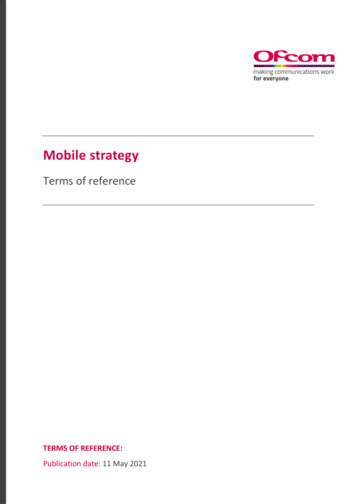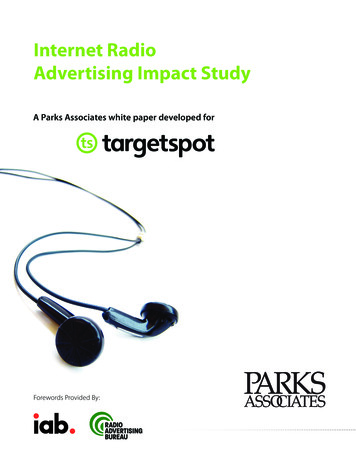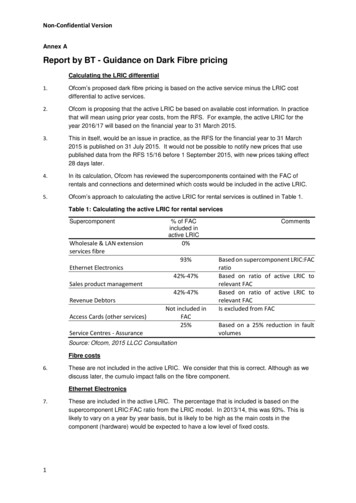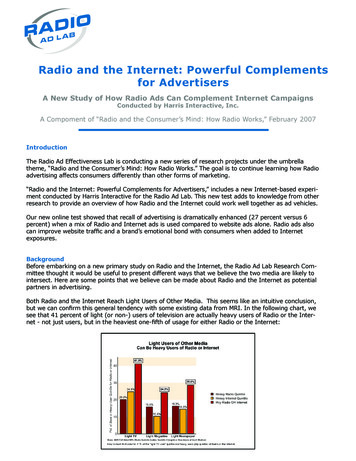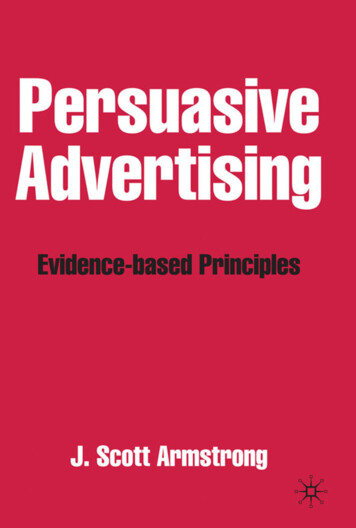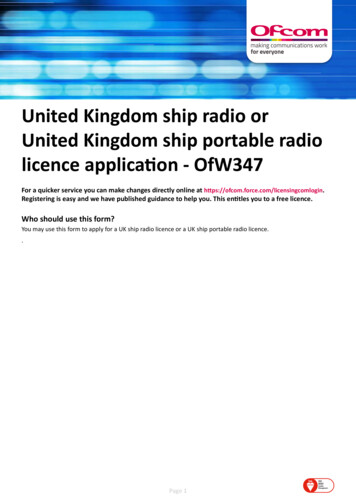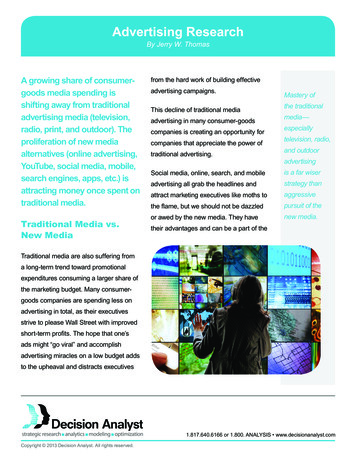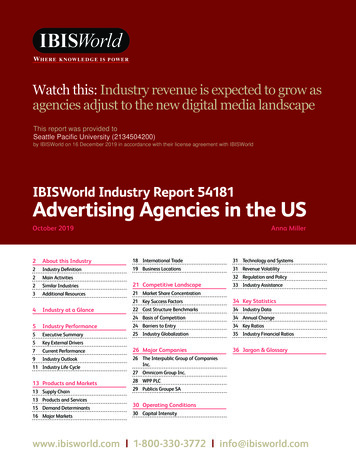
Transcription
Radio Advertising Market ResearchRadio Advertising MarketResearchAssessment of the constraints on the price of directand indirect radio advertisingPublication date:19 October 2006
Radio Advertising Market ResearchContentsSectionPage1Executive Summary12Introduction33Background to radio advertising64Trading radio advertising115Direct and indirect radio advertising market definition176Method of analysis207Competitive constraints on direct radio advertising278Competitive constraints on indirect radio advertising49Annex1PageInclusion of additional gain in revenue from partial switchers toother media682Different values for the average budgets703Different number of partial and full switchers724Magnitude of price increase imposed765Inclusion of cost savings from reduced royalty and licence feepayments786Inclusion of cost savings from reduced advertising sales activity 807Profitability analysis858Calculation of cost savings from reduced indirect radioadvertising sales activity929Comparison of spend profiles between survey switchers and fullsurvey sample for sample of direct radio advertisers95Market Research Report - Harris Interactive (published separately)Market Research Report - Human Capital (published separately)
Radio Advertising Market ResearchSection 11 Executive Summary1.1Ofcom is the independent regulator and competition authority for the UKcommunications industries. Ofcom undertook this research to develop itsunderstanding of the radio advertising industry and the competitive constraints facedby suppliers of radio advertising airtime. In particular Ofcom was interested inunderstanding the extent to which pricing in radio advertising markets appears to beaffected by other media.1.2The Competition Commission last examined the provision of radio advertising in May2003. Since this time the radio and advertising industry has developed in a number ofways which may have affected the competitive landscape. These developmentsinclude: a decline in commercial radio advertising revenue; the BBC’s increased market share of radio listening; the growth in DAB digital radio penetration; online and outdoor advertising growth; and a decline in press circulation.This research allows Ofcom to examine the radio advertising industry in the light ofthese changes.1.3Ofcom conducted a survey based programme of qualitative and quantitativeresearch. The research allowed Ofcom to analyse which media appear to impose thestrongest competitive constraint on the pricing of radio advertising. In addition, itoutlines the drivers of demand for radio advertising, the decision-making process formedia purchasing, advertisers’ attitudes towards radio in the context of other mediaoptions, and the impact on the demand for radio advertising following an increase inthe relative price of radio advertising.1.4In its submissions to the OFT in relation to recent radio mergers, Ofcom has definedtwo separate radio advertising markets; direct and indirect. Direct radio advertising occurs where the advertiser purchases airtime byapproaching the sales teams at individual radio stations separately. Indirect radio advertising occurs where an advertiser uses a media buyingagency to manage its purchase of advertising on radio stations via a radiogroup’s advertising sales house.In this research the constraints faced by suppliers of direct radio advertising andindirect radio advertising have been assessed separately.1.5Findings from the analysis of direct radio advertising include: The pricing of direct radio advertising appears to be constrained by pressadvertising. As a result, a hypothetical monopoly supplier of direct radio1
Radio Advertising Market Definition Researchadvertising would not find it profitable to raise prices by 5-10% for a sustainedperiod of time. This result appears to be robust to a range of sensitivity analyses. 1.61.72Evidence suggests that direct radio advertisers perceive radio and pressadvertising as interchangeable.Findings from the analysis of indirect radio advertising include: Television, online and press advertising pose the strongest competitiveconstraints on the pricing of indirect radio advertising. An increase in the price of indirect radio advertising would result in media buyingagencies moving budgets away from radio to a range of alternative media. Thesealternative media taken together appear to collectively constrain the pricing ofindirect radio advertising. As a result, a hypothetical monopoly supplier of indirectradio advertising would not find it profitable to raise prices by 5-10% for asustained period of time. Media buying agencies appear to have a degree of countervailing buyer power,and therefore, would be likely to try and negotiate down any attempted increasein the price of indirect radio advertising.The conclusions of this study are intended to act as a starting point for Ofcom incases where an understanding of the radio advertising industry and the competitiveconstraints faced by radio advertising is required. In the context of a complaint,dispute, market review or in providing submissions to the OFT in relation to mergersthe precise scope of the relevant product and geographic market would need to beassessed based on the specific circumstances and facts of the particular case inquestion.
Radio Advertising Market ResearchSection 22 Introduction2.1Ofcom is the sectoral regulatory authority for the radio industry. As sectoral regulator,Ofcom has a number of competition related functions and duties:2.1.1Ofcom has concurrent powers with the OFT under the Competition Act1998 (the "Competition Act") to deal with anti-competitive agreements andconduct by applying Article 81 and Article 82 of the EC Treaty and theChapter I and Chapter II prohibitions of the Competition Act;2.1.2Ofcom also has powers to make a market investigation reference to theCompetition Commission where it has reasonable grounds for suspectingthat a feature or combination of features of the market in the UK prevents,restricts or distorts competition;2.1.3In addition, Ofcom has powers to use conditions in various licences underthe Broadcasting Act 1990 and 1996 (the "Broadcasting Acts") to ensurefair and effective competition in the provision of licensed services andconnected services;2.1.4More generally, Ofcom has a number of duties under the CommunicationsAct 2003. It is Ofcom's duty to further the interests of consumers in relevantmarkets where appropriate by promoting competition, and to have regard incarrying out its duties to a number of elements as relevant in thecircumstances, including the desirability of promoting competition in therelevant markets; and2.1.5Although the OFT has responsibility for merger control in the UK, Ofcommay also be asked by the OFT to provide it with Ofcom’s views on amerger or proposed merger in areas where Ofcom has sector specificknowledge.2.2It is important for Ofcom to have a strong evidence base for all areas of its remit.Hence Ofcom has undertaken this study in order to allow it to develop a robust,evidence-based understanding on how purchasing decisions regarding advertising inradio are made, what factors influence that decision and the extent to which pricing inradio advertising markets appears to be constrained by other media.2.3In order to understand these issues, Ofcom undertook a detailed, survey-basedprogramme of qualitative and quantitative research.1 The research sought tounderstand the drivers of demand for radio, the media purchase decision-makingprocess, the attitudes towards radio in the context of other media, and the extent to1In the absence of available market data on pricing and switching, the analysis has been conductedusing evidence from a market research survey. The SSNIP (small but significant non-transitoryincrease in price) test methodology adopted by Ofcom necessitated asking respondents what theirreactions would be to a hypothetical industry-wide price increase. Survey responses given tohypothetical questions should be treated with caution and the methodological limitations of Ofcom’sapproach are set out in section 7.9. The results are presented acknowledging this fact. The researchalso measured attitudes and behaviours of radio advertising purchasers, which appear to beconsistent with responses given to the SSNIP test questions. In conducting analysis in the context ofa specific case, Ofcom would ideally where possible seek to use available information on actualswitching behaviour alongside any survey results.3
Radio Advertising Market Definition Researchwhich other media constrain the price of radio advertising, including how advertisersand media buyers (on behalf of their advertising clients) would react to an increase inthe relative price of radio advertising. The research gathered the data required toallow Ofcom to analyse what media appear to impose the strongest competitiveconstraint on the pricing of radio.22.4The provision of radio advertising was last examined by the Competition Commissionin May 2003 in the context of the proposed merger between Scottish Radio Holdingsplc, GWR Group plc and Galaxy Radio Wales and the West Ltd3 and more recentlyby the OFT in the context of the proposed merger between Capital Radio plc andGWR Group plc4 in December 2004 and the acquisition by Emap plc of ScottishRadio Holdings plc5 in August 2005. Ofcom has taken the opportunity to undertakethis project outside the context and associated statutory time limits of a mergerinvestigation, enabling Ofcom to conduct its research and analysis over a longertimeframe.2.5The radio advertising industry in the UK has undergone a number of developmentssince the Competition Commission last examined the provision of radio advertising inMay 2003 which may have contributed to a change in the competitive landscape.Some of the key factors include, but are not limited to:2.622.5.1the increasing listening share of the BBC relative to the commercial radiosector;2.5.2a decline in commercial radio advertising revenue;2.5.3the increasing development and penetration of DAB digital radio;2.5.4the growth in online and outdoor advertising; and2.5.5a decline in press circulation.The conclusions contained in this report are intended to constitute Ofcom’s startingpoint in cases where an understanding of the competitive constraints faced by radioadvertising is required - whether in the context of a complaint, dispute, market reviewor in providing submissions to the OFT in relation to mergers. The conclusions do notpropose to define the boundaries of the relevant product market. The precise scopeof the relevant product market for direct and indirect radio advertising would need tobe assessed based on the specific facts and circumstances of the particular casebeing examined.We have analysed the constraint imposed on the pricing on radio by other media by applying thehypothetical monopolist test. This test is a useful economic tool which considers whether ahypothetical monopolist supplier of the product or group of products in question (in the present caseradio advertising airtime) would find it profitable to raise prices by a small but significant proportion fora sustained period of time. If this course of action is shown to be unprofitable for the hypotheticalmonopolist, this suggests that the product or group of products in question place a competitiveconstraint on the price of radio advertising airtime. This test is also known as the SSNIP test (smallbut significant non-transitory increase in price). This is further explained in section 5.1.3The Competition commission report can be found at: http://www.competitioncommission.org.uk/rep pub/reports/2003/479radio.htm4The OFT decision can be found at: 7ADB5BE-63834E977AFC/0/capital.pdf5The OFT decision can be found at: 54A-860FC4E03326F0F9/0/Emap.pdf and Ofcom’s statutory assessments can be found at:http://www.ofcom.org.uk/media/news/2005/08/nr 200508084
Radio Advertising Market Research2.7This report does not assess the constraints faced by suppliers of radio advertising inone area from suppliers of radio advertising and other forms of media in differentgeographic areas. The constraints faced by suppliers of radio advertising fromsuppliers of radio advertising in other areas and from alternative media may varyacross the country and across regions. This report does not attempt to reach a viewon the scope of the relevant geographic market.2.8A view on the product and geographic scope of the relevant market will, of course,need to be formed on a case by case basis by reference to the specific facts orcircumstances of the particular case at hand.2.9Throughout this report a distinction is made between the two distinct methodsthrough which radio advertising is sold: direct (or local) radio advertising, and indirect(or national) radio advertising. Direct advertising refers to the situation where theadvertiser purchases airtime by approaching the sales team at each individualstation, separately station by station. Indirect advertising refers to the situation wherean advertiser employs the services of a media buying agency to manage itspurchases of advertising on individual stations or clusters of stations, purchasing thisairtime through a single point of sale (the radio group’s advertising sales house).2.10The rest of this report is structured as follows:2.10.1Section 3 provides a background description of radio advertising;2.10.2Section 4 describes how trading in radio advertising takes place;2.10.3Section 5 sets out the arguments why direct and indirect radio advertisingare in separate relevant product markets;2.10.4Section 6 describes Ofcom’s method of analysis;2.10.5Section 7 sets out Ofcom’s approach and findings from the quantitative‘hypothetical monopolist’ test analysis in respect of direct radio advertising,combined with the findings from other quantitative and qualitative surveyevidence; and2.10.6Section 9 presents the same analysis as Section 8 but in relation to indirectradio advertising.2.10.7The appendices contain some of the detail of Ofcom’s hypotheticalmonopolist test analysis conducted for direct and indirect radio advertising.2.10.8The market research reports based on the surveys conducted byindependent market research consultancies are included as supportingdocuments. Supporting document volume 1 contains Harris Interactive’smarket research report on direct and indirect radio advertising. Supportingdocument volume 2 contains Human Capital’s market research report ofindirect advertising.5
Radio Advertising Market Definition ResearchSection 33 Background to radio advertising3.1. Brief overview of the advertising industry3.1Advertising is an important market as it constitutes one of the major means of fundingfor the media industry. The advertising industry also plays an important role in theeconomy, as it provides one of the means for companies in different sectors tocompete with each other for consumer spend.3.2Total advertising expenditure has increased over time, and it now constitutes a nonnegligible share of UK GDP. In 2005, total advertising expenditure was almost 18billion6, or around 1.6% of GDP.3.3Although press and TV remain the two major media in terms of total advertisingexpenditure, the mix of advertising media has been changing over time and newmedia have come into play.3.4As shown in Table 1 below, media such as direct mail, outdoor, radio and cinemahave gained market share of total display advertising expenditure to the detriment ofpress and TV advertising. Internet advertising, which first appears in advertisingstatistics in the second half of the 1990s, has experienced very strong growth.Table 1: Total display advertising7 expenditure in the UK, percentage of UK %35.6%33.2%34.1%33.1%32.9%32.7%Direct 7.5%16.1%Outdoor 100%Source: Advertising statistics yearbook 2006Note: includes production costs3.5On the supply side, there is a range of market players. While some players are onlypresent in one medium, others have interests across different media (e.g. Emapacross press and radio).3.6On the demand side, advertising is purchased by businesses across different sectorsof the economy and products, such as consumables, durables, retail, government orservices markets.6At current prices, including display and classified advertising, and production costs. Total advertisingexpenditure excluding classified advertising and including production costs was over 13 billion in2005.7The Advertising Association defines display advertising as all advertising excluding press classifiedadvertising.6
Radio Advertising Market Research3.73.8The media choice of advertisers appears to be driven by four key factors:3.7.1the campaign objectives;3.7.2the ability of individual media to reach the target audience;3.7.3the media coverage/reach (e.g. whether specific geographic reach ornational); and3.7.4the campaign budget.Ability to reach the target audience and suitability to campaign objectives appearfrom the research to be the two major drivers for the choice of media. Campaignobjectives can dictate target audience, geographic coverage and budget. Budget isnot always a primary consideration for advertisers (although it can be for smallerbusinesses), although the media must be cost-effective.83.2. Overview of radio advertisingTrends in radio advertising spend3.9As shown in Table 1 above, radio accounts for a small share of total advertisingexpenditure (just under 4%) following consistent increases in radio’s share of totaldisplay advertising expenditure in the late 1990s. Table 2 below shows that between1995 and 2005, radio advertising revenues more than doubled, growing from 296million to 579 million.9Table 2: Total display advertising10 expenditure in the UK, 3214,6464,1474,3494,3784,6534,820Direct ,4692,371Outdoor ,75213,21714,13014,723Source: Advertising statistics yearbook 2006Note: includes production costsThe supply of radio advertising3.10The number of commercial radio stations has almost doubled in the last ten years.There were 280 analogue commercial radio stations in 2005. However, a degree ofconsolidation has also taken place over the last few years, notably with the mergers8Supporting document vol 1. For a description of the methodology of this research see section 6.The Advertising Statistics Yearbook 2006, current prices.10The Advertising Association defines display advertising as all advertising excluding press classifiedadvertising.97
Radio Advertising Market Definition Researchbetween GWR/Capital and Emap/SRH. Therefore, audiences today are morefragmented across radio stations (but not across radio groups).3.11The major radio groups in the UK by share of radio advertising revenues are GCap,Emap/SRH and Chrysalis. As shown in table 3 below, together they account foralmost 75% of UK radio advertising revenues.Table 3: Share of UK radio advertising revenues 2005*Radio groupPercentage of totalGCap34%Emap/SRH25%Chrysalis12%GMG5%Classic Gold Digital Ltd5%Ulster Television4%The Local Radio Company3%SMG2%CN Group2%UKRD2%Lincs1%Sunrise1%Saga1%Tindle1%Kent MessengerLess than 1%MilestoneLess than 1%ForwardLess than 1%Other3%TOTAL100%*Based on gross broadcasting revenue (GBR)Source: Ofcom3.12118Commercial radio stations derive the majority (around 86%)11 of their total revenuesfrom the sale of airtime to advertisers and sponsors. As shown in table 4, advertisingairtime sales account for approximately 86% of total net advertising revenue (NAR),with the remainder mostly accounted for by sponsorship and promotions.Source: Ofcom
Radio Advertising Market ResearchTable 4: Commercial radio station net advertising revenues200320042005Advertising revenues84%84%86%Sponsorships & Promotions16%16%14%Total NAR100%100%100%Source: OfcomNAR Net advertising revenue3.13Commercial production revenues are a very small proportion of the industry total.123.14Ofcom does not regulate the amount of airtime that radio stations can offer toadvertisers. However, standard industry practice involves setting a “ceiling” for thenumber of minutes of advertising to be broadcast per hour: 9-12 minutes per hour isstandard across the industry (although recently GCap has reduced the supply ofradio advertising minutage by up to half on its London’s station Capital FM). Thisceiling is driven by listeners’ reluctance to tolerate too much advertising, especiallygiven the constraint imposed by the BBC which airs no advertising. This ceilingincludes minutes of sponsorship and promotion airtime as well as “traditional”advertising.3.15Radio stations sell advertising airtime in two ways: either on a cost per thousand(CPT) basis, or as “spot” advertising. CPT refers to the cost for each thousandpeople that hear a 30 second advertisement at a certain time (e.g. a cost for eachthousand people that hear a 30 second advertisement during next Monday’sbreakfast show). Stations also sell spot advertising which gives a total cost to aparticular period of airtime (e.g. 30 seconds during next Monday’s breakfast show).3.16Sponsorship and promotion (S&P) are relatively new commercial activities in radio.Industry revenue from these sources is growing quickly. Sponsorship tends to involvea higher level of presenter participation than is the case for traditional advertising. Asa result, sponsorship tends to build a stronger relationship with the audience, and isoften used by large advertisers on a long-term basis for brand building purposes.Promotions tend to be much shorter, typically lasting for a week or a weekend, andare more focused on immediate sales generation. S&P tends to be sold on the samebasis as standard advertising, either on a CPT or spot basis.3.17While analogue radio generates the majority of commercial radio advertisingrevenues13, the digital radio advertising market is still in its infancy, given the currentrelatively low listenership to digital services. However, the industry expects thatrevenues from digital services will increase over the coming years once penetrationof digital radio sets and listening to digital services reach higher levels. Digital radioadvertising is bought and sold on the same basis as analogue radio advertising.RAJAR14 captures all listening without differentiating between listening on analogueor digital. Consequently for many stations, analogue and digital radio advertising areeffectively being sold together.12RAB, July 2004In 2005, national and non-national commercial analogue radio net advertising revenues accountedfor around 440 million while digital only net advertising revenues accounted for less than 4 million(source: Ofcom).14RAJAR (Radio Joint Audience Research Limited) is a company that operates a single audiencemeasurement system for the UK radio industry – BBC, UK licenced and other commercial stations.139
Radio Advertising Market Definition ResearchThe demand for radio advertising3.18Radio advertisers range across different sectors of the economy. In 2005, the topradio spending sectors were motors, entertainment and media, and retail15.3.19Radio advertisers also range in size from the Central Office of Information (COI) andProcter and Gamble who spend millions of pounds every year on radio advertising, tosmall local advertisers who spend less than one hundred pounds per year.3.20Table 5 below shows the radio advertising expenditure of the top ten radioadvertisers in 2005. The top ten radio advertisers accounted for over 15% of totalradio advertising expenditure in 2005.Table 5: Top 10 radio advertisers in 2005Advertiser ,000sCOI Communications32,867Unilever10,252British Sky Broadcasting6,175Abbey National6,119BT5,886Vodafone5,602Vauxhall Motors5,548Renault5,442Camelot Group5,248Procter & Gamble5,159Source: Advertising Statistics Yearbook 20063.2115Evidence from the Harris Interactive and Human Capital market research reports(see supporting documents vol 1 and vol 2) suggests that radio’s major distinctivecharacteristics appear to be its wide audience/high penetration and its ability to betarget specific audience demographics and/or specific geographic regions. Otherappealing characteristics include, among others, the frequency of opportunities tohear, the instant impact, the status symbol for local companies or the speed, shortlead times and relatively low cost of advertising production.16 The potential drivers ofdemand for radio advertising set out above are explored in more detail in theAdvertising Statistics Yearbook 2006Supporting document vol 1 and supporting document vol 2. For a description of the methodology ofthis research see section 6.1610
Radio Advertising Market ResearchSection 44 Trading radio advertising4.1. Direct and indirect radio advertising4.1There are two principal routes to market for advertisers seeking to purchase radioadvertising airtime:4.1.1“direct advertising”, where an advertiser approaches the sales team at eachindividual station, separately station by station. The industry typically refersto this type of purchase as “local advertising” as it is the approach generallyused by local advertisers who wish to advertise on one or a small numberof specific local stations.4.1.2“indirect advertising”, where an advertiser employs the services of a mediabuying agency to manage its purchases of advertising on individual stationsor clusters of stations, purchasing this airtime through a single point ofsale17 (the radio group’s advertising sales house). This is called “nationaladvertising” by the industry as it is the method typically used by largeadvertisers who wish to advertise their product generally to customersacross large parts of the country.Market size – direct and indirect radio advertising4.2Indirect radio advertising accounts for a larger share of total radio advertisingrevenues than direct advertising. Table 6 below shows the split of radio advertisingrevenues for direct and indirect radio advertising.Table 6: Direct and indirect radio advertising – net advertising revenues* (NAR)200320042005Direct NAR39%39%37%Indirect NAR61%61%63%TOTAL100%100%100%Source: Ofcom* Net advertising revenue excludes S&P and commissions4.2. The sale and purchase of radio advertising airtime4.3Figure 1 is a stylised representation of the process by which radio advertising is sold.The role of each element in the process is discussed in greater detail below.17Though it should be noted that the advertiser will generally still pay a different price for airtime oneach individual station that it buys from.11
Radio Advertising Market Definition ResearchFigure 1: The radio advertising sales processDirect advertisingAdvertiserRadio Station IndirectadvertisingAirtimeProduction of advertCreative Agency Creative strategyDesign andproduction of advertRadio Group SalesHouseMedia Buying Agency Radio Station AirtimeProduction of advertMedia PlanningMedia buyingSource: OfcomThe advertiser4.4The advertiser is the primary source of a radio station’s income. As explained inparagraph 3.19, radio advertisers range substantially in size. Table 5 in Section 3shows the advertising spend for the top 10 radio advertisers in 2005.184.5As described above, direct advertisers will tend to deal directly with their local radiostation. Indirect advertisers will tend to employ the services of an advertising agencyto manage their purchases of advertising on individual radio stations or clusters ofstations, who would then purchase the airtime through the radio group’s advertisingsales house.194.6Advertisers determine their overall advertising budget. Direct advertisers also decidehow much of it they wish to spend on radio. For indirect advertisers this decision islikely to be made jointly with, or solely by the planners at an advertising agency,although some indirect advertisers will have more influence on the media mix thanothers.Creative agencies4.718Indirect advertisers typically employ the services of creative agencies to take a leadrole in developing the creative and branding strategy for an advertising campaign aswell as designing and producing the advertisement. Creative agencies may alsocontribute to the formulation of an advertising client’s media strategy, together withTable 5 shows that the Central Office of Information and Proctor and Gamble spent 33million and 5 million in 2005 respectively.19The above does not hold true in all cases for national advertisers. In some cases, even though alarge advertiser may use an agency to purchase the airtime, it may also have a direct relationship witha radio group’s sales house. For example, the sales house may pitch for business direct to anadvertiser, who will then use a media buying agency to purchase the airtime from the sales house.12
Radio Advertising Market Researchthe media planners at media buying agencies, where certain creative ideas workbetter in one medium than another.Media buying agencies4.8Indirect advertisers also generally appoint the services of a media buying agency toensure that all elements of its advertising campaign are delivered in the m
radio advertising markets appears to be constrained by other media. 2.3 In order to understand these issues, Ofcom undertook a detailed, survey-based programme of qualitative and quantitative research.1 The research sought to understand the drivers of demand for radio, the media purchase decision-making
